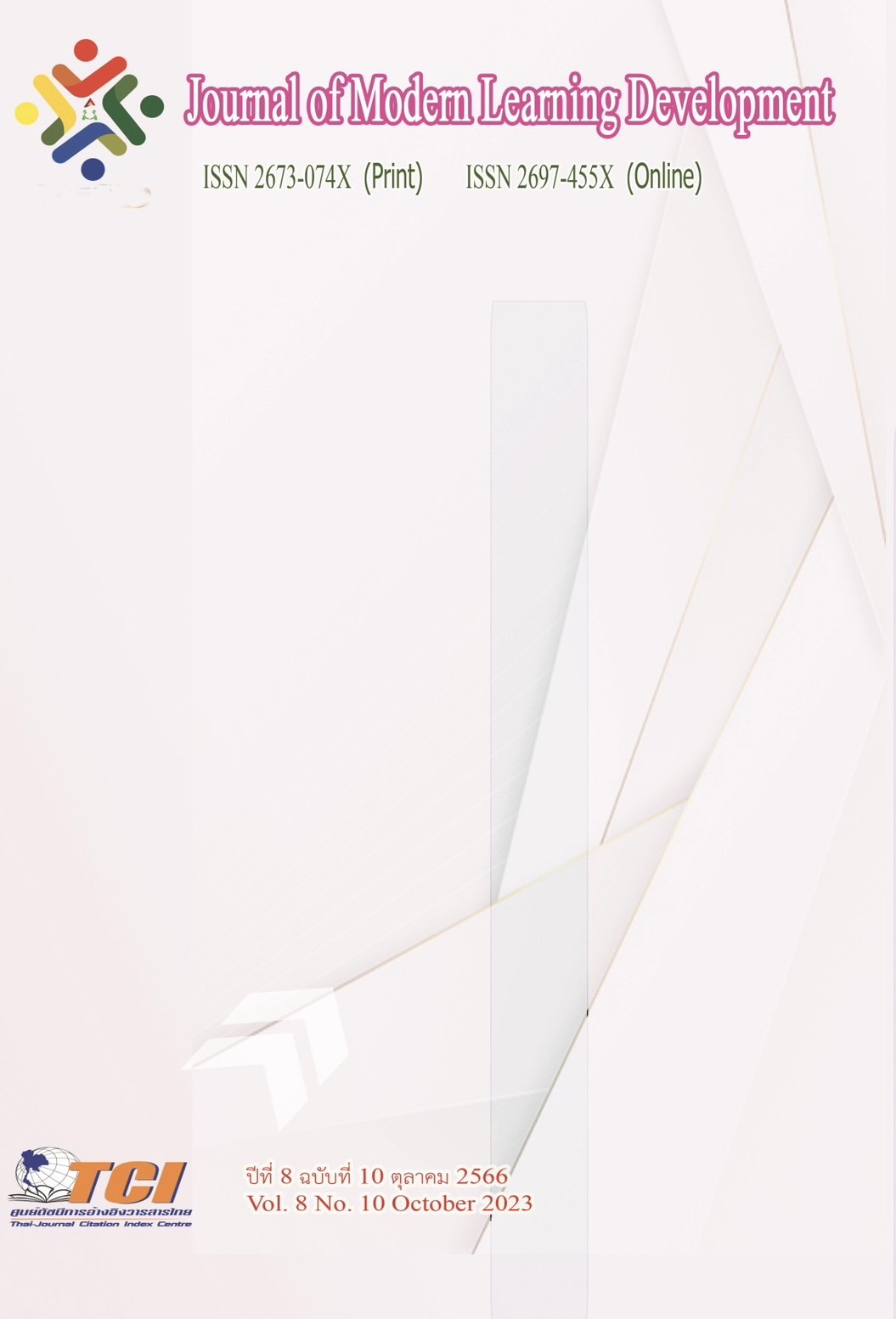The Development of Mathematic Electronic Books in Addition and Subtraction for Prathomsuksa 4th Students, Khehachomchonladkrabang School
Main Article Content
Abstract
The purposes of this research were to (1) construct electronic books and find the efficiency of mathematic electronic books in addition and subtraction for Prathomsuksa 4th students to be effective, as ofthe standardized criterion 80/80 (2) compare the effectiveness of mathematic achievemnent in addition and subtraction for Prathomsuksa 4th students after using electronic books and the normal learning. This research is a quasi – experimental research. The sample for research consisted of 70 Prathomsuksa 4th students at Khehachomchonladkrabang School of 2 classes during semester 1 in the academic year 2022. Selected by sample random sampling from lottery method. Divided into 2 groups, which are the experimental group teaching by using electronic books. Mathematics on addition,subtraction and the control group teach using normal teaching. Research tools (1) the mathematic electronic books in addition and subtraction (2) lesson plan of using mathematics electronic books in addition and subtraction (3) achievement test The confidence value of the test was 0.831. The data were analyzed using, Percentage , mean, standard deviation, and t-test independent test samples.
The research findings revealed that
1) the efficiency of the mathematics electronic books in addition and subtraction for Prathomsuksa 4th was 81.60/81.83 which was higher than the criterion of 80/80
2) the students mathematics achievement in addition and subtraction after using mathematic achievement in addition and subtraction test was significantly higher than the students using the normal learning teaching at the .05 level.
Article Details
References
กระทรวงศึกษาธิการ.(2560). ตัวชี้วัดและสาระการเรียนรู้แกนกลาง กลุ่มสาระการเรียนรู้คณิตศาสตร์ (ฉบับปรับปรุง พ.ศ. ๒๕๖๐) ตามหลักสูตรแกนกลางการศึกษาขั้นพื้นฐาน พุทธศักราช ๒๕๕๑ . กรุงเทพมหานคร: โรงพิมพ์คุรุสภาลาดพร้าว.
ขจรศักดิ์ ทองรอด. (2558). กระบวนการพัฒนาหนังสืออิเล็กทรอนิกส์แบบสื่อประสมเพื่อสนับสนุนการ เรียนรู้. Suranaree Journal of Social Science. 10 (1), 105–118.
จิตราภา กาวิชัย. (2563). การพัฒนาหนังสืออิเล็กทรอนิกส์ เรื่องเศษส่วน เพื่อพัฒนาผลสัมฤทธิ์ทางการ เรียนวิชาคณิตศาสตร์ สำหรับนักเรียนชั้นประถมศึกษาปีที่ 5 โรงเรียนคลองหนองใหญ่ (ทองคำ ปานขำอนุสรณ์). Journal of Educational Innovation and Research. 5 (2), 238 – 251.
รัตนาภรณ์ มามีใย. (2563). การเปรียบเทียบผลสัมฤทธิ์ทางการเรียนวิชาสังคมศึกษา เรื่อง หลักธรรมทางพระพุทธศาสนา ของนักเรียนชั้นประถมศึกษาปีที่ 2 ระหว่างการสอนโดยใช้หนังสืออิเล็กทรอนิกส์ (E-Book) ชุดหนูบัวเบิกบานธรรม กับการสอนแบบปกติ. วารสารนวัตกรรมการศึกษาและการวิจัย. 5 (2), 343 – 354.
ลลิดา เกตุเอม. (2555). การพัฒนาหนังสืออิเล็กทรอนิกส์วิชาภาษาอังกฤษเรื่อง Food and Drinks ของนักเรียนชั้นประถมศึกษาปีที่ 6 ศูนย์การเรียนรู้เครือข่ายโรงเรียนขนาดเล็กโรงเรียนวัดนา ขวาง อำเภอเมือง จังหวัดสมุทรสาคร. การค้นคว้าแบบอิสระศึกษาศาสตรมหาบัณฑิต. บัณฑิตวิทยาลัย: มหาวิทยาลัยศิลปากร.
แวววิไล จำปาศักดิ์. (2560). การพัฒนาหนังสืออิเล็กทรอนิกส์ เรื่อง ลักษณนาม กลุ่มสาระการเรียนรู้ภาษาไทย สำหรับนักเรียนชั้นมัธยมศึกษาปีที่ 3. การค้นคว้าอิสระศึกษาศาสตรมหาบัณฑิต. บัณฑิตวิทยาลัย: มหาวิทยาลัยรามคำแหง.
ศรราม สุขสําราญ. (2564). การพัฒนาผลสัมฤทธิ์ทางการเรียนวิชาวิทยาการคำนวณ เรื่อง การจัดการข้อมูล ของนักเรียนชั้นมัธยมศึกษาปีที่ 5 โดยใช้หนังสืออิเล็กทรอนิกส์ชุดเทคโนโลยีการจัดการข้อมูล.การค้นคว้าแบบอิสระศึกษาศาสตร์มหาบัณฑิต. บัณฑิตวิทยาลัย: มหาวิทยาลัยรามคำแหง.
สถาบันทดสอบทางการศึกษาแห่งชาติ. (2564). ระบบประกาศและรายงานผลสอบโอเน็ต. ออนไลน์. สืบค้นเมื่อ 25 กันยายน 2565. แหล่งที่มา: http://www.newonetresult.niets.or.th/Announcement Web
สุฑามาศ แก้วมรกต. (2563). การพัฒนาหนังสืออิเล็กทรอนิกส์ เรื่อง การออกแบบภาพกราฟิก สำหรับนักเรียนชั้นมัธยมศึกษาปีที่ 2 โรงเรียนเศรษฐบุตรบำเพ็ญ. วารสารนวัตกรรมการศึกษาและการวิจัย. 5 (2), 303 – 317.


